Module 2 Unit 2 教案
- 格式:doc
- 大小:21.50 KB
- 文档页数:3

外研版(一起)二年级英语上册《Module 2 Unit 2》教案设计一、教学目标1. 知识与技能目标:学生能够听懂、会说、会读本课的单词和句子;学生能够理解并在实际情景中运用句型“Can I ?”和“Yes, you can./ No, you can’t.”;学生能够理解一般疑问句的意义和用法。
2. 过程与方法目标:通过听、说、读、写的活动,培养学生的英语听说能力和阅读能力;通过小组合作和角色扮演,培养学生的合作能力和表达能力。
3. 情感态度与价值观目标:激发学生学习英语的兴趣和积极性;培养学生的自信心和自主学习能力;培养学生尊重他人、礼貌待人的良好品质。
二、教学内容1. 词汇:ball, toy, bag, book, ruler, pencil, pen, pencilcase, crayon, tape, scissors, gluestick, eraser, Sharpener, can, can’t。
2. 句型:Can I ?Yes, you can./ No, you can’t.3. 功能:询问并回答是否可以做某事。
三、教学重点与难点1. 教学重点:词汇的学习和记忆;句型的理解和运用。
2. 教学难点:一般疑问句的意义和用法;词汇的发音和书写。
四、教具与学具准备1. 教具:PPT、录音机、教学卡片、黑板、粉笔。
2. 学具:英语课本、练习本、铅笔、彩色笔。
五、教学过程1. 导入:通过唱英文歌曲或做游戏,激发学生的学习兴趣,营造轻松愉快的学习氛围。
2. 新课展示:通过PPT展示本课的词汇和句型,让学生听录音并跟读,帮助学生理解并记忆。
3. 操练:通过小组合作和角色扮演,让学生在实际情景中运用本课的词汇和句型,培养学生的合作能力和表达能力。
4. 巩固:通过听、说、读、写的活动,巩固学生对本课词汇和句型的理解和运用。
六、板书设计1. Module 2 Unit 22. 词汇:ball, toy, bag, book, ruler, pencil, pen, pencilcase, crayon, tape, scissors, gluestick, eraser, Sharpener, can, can’t.3. 句型:Can I ?Yes, you can./ No, you can’t.七、作业设计1. 听力练习:听录音,选择正确的图片。
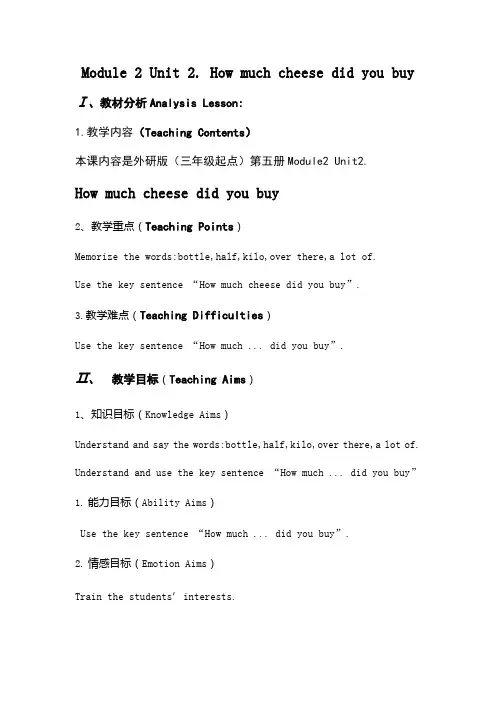
Module 2 Unit 2. How much cheese did you buy Ⅰ、教材分析Analysis Lesson:1.教学内容(Teaching Contents)本课内容是外研版(三年级起点)第五册Module2 Unit2.How much cheese did you buy2、教学重点(Teaching Points)Memorize the words:bottle,half,kilo,over there,a lot of.Use the key sentence “How much cheese did you buy”.3.教学难点(Teaching Difficulties)Use the key sentence “How much ... did you buy”.Ⅱ、教学目标(Teaching Aims)1、知识目标(Knowledge Aims)Understand and say the words:bottle,half,kilo,over there,a lot of. Understand and use the key sentence “How much ... did you buy”1.能力目标(Ability Aims)Use the key sentence “How much ... did you buy”.2.情感目标(Emotion Aims)Train the students’interests.Ⅲ、Teaching Resource:Cards ,PPTⅣ、Teaching Steps:1、 Warming:(1 minutes)GreetingSing an English song <How many do you want?>.2、 Leading in:(2 minutes)1. Duty report(Now duty report. ... Well done!)the countable nouns uncountable nouns.(What did you do at the weekend? I went are something I bought.(PPT)Please look at the screen .After shopping,I put all the thing in a big bag,it’s clutter,can you help me tidy them? )(ppt)For example,apples are in ,because we can say apple,’s a countable noun,juice is in ,it’s a uncountable noun,only juice,?)the using way of ‘How many’ .---How many apples/bananas/pears/oranges did I buy?--- ...3、 Learning key sentences:(10 minutes)the words: cheese,kilo,half.What’s this?---it’s cheese. We can say half s kilo of cheese ,one kilo cheese,two kilos of cheese.What’s this?---it’s a bottle. One bottle,two bottles.2.Learn the using way of ‘How much’1).Teach by the teacher.(I’m a saleclerk “你想要多少奶酪?”I can say“How much cheese do you want?”---Half a kilo./ One kilo.“How much juice do you want?”--- Two bottles.2).Practice by the students.Practice with partners.(Look at the screen, please ask and answer with your partners. ) Show the Practice.3.Summarize the using way of “how many ,how much”.(Do you find how to use “how many ,how much”。
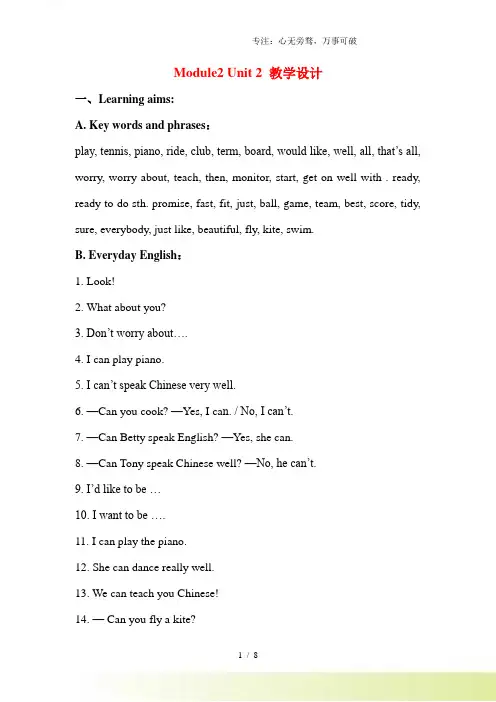
Module2 Unit 2 教学设计一、Learning aims:A. Key words and phrases:play, tennis, piano, ride, club, term, board, would like, well, all, that’s all, worry, worry about, teach, then, monitor, start, get on well with . ready, ready to do sth. promise, fast, fit, just, ball, game, team, best, score, tidy, sure, everybody, just like, beautiful, fly, kite, swim.B. Everyday English:1. Look!2. What about you?3. Don’t worry about….4. I can play piano.5. I can’t speak Chinese very well.6. —Can you cook? —Yes, I ca n. / No, I can’t.7. —Can Betty speak English? —Yes, she can.8. —Can Tony speak Chinese well? —No, he can’t.9. I’d like to be …10. I want to be ….11. I can play the piano.12. She can dance really well.13. We can teach you Chinese!14. — Can you fly a kite?—Yes, I can. / No, I can’t.C. Teaching aims:1. Function: Finding out what people can do; asking and answering about abilities2. Structure: can / can’t3. Skills: 1)Listening and finding out about people’s abilities.2) Supplying information on p eople’s abilities.3)Reading and understanding simple passages, finding specific information4) Composing a simple passage4. Around the world: Languages5. Task: Making a poster for a club.二、Keys and Difficulties:The correct usage “can and can’t”.三、Teaching plan:Unit 2 I can run really fast.ⅠTeaching modelReading and writing.ⅡTeaching methodTop-down approachⅢTeaching keys and difficulties.The key points:a.key vocabulary and phrases: monitor, start, get on well with .ready, ready to do sth. promise, fast, fit, just, ball, game, team,best, score, tidy, sure, everybody, just like, beautiful, fly, kite,swimb.key structures:I’d like to be…I want to be….Difficulties.To write something about the monitor you would like to be.ⅣTeaching Aims1.Knowledge Aims:a.to grasp the key words and phrase.b.To get information from the reading material.2.Ability Aims:a.To get the Ss to describe the personal advantages and abilitiesb. To discuss about running for class monitorsc. To know which monitor the students would like to be for yourclass.d. To write something about the monitor you would like to be.3.Emotional Aims:To develop their awareness that we should affirm one’s ability and enhance self-confidence.ⅤTeaching aidsRecorder, PPT, videoⅥTeaching StepsStep 1 Warming-up and learn the vocabulary(3’)1. Show some pictures to review the words. .2. Read the words after the top student.4. Introduce the new words.Step 2 Discussion: work in pairs(4’)1. Show some pictures to tell the students what the class monitor, PE monitor and the cleaning monitor should do.2. Work in pairs. Ask and answer the questions.1) Which monitor would you like to be for your class?Class monitorPE monitorCleaning monitor2) What do these monitors do?Step 3 Listen and Fast Reading.(6’)1. Play the recording.2. Ask the students to read through the passage.3. Read the passage and check (√) the true sentences.1) Lingling doesn’t get on well with others.2) Lingling is kind to everyone.3) Daming is good at sport so he wants to be the PE monitor.4) Daming plays football for the school.5) Tony doesn’t like cleaning.6) Tony’s home is tidy.4. Check with a partner.5. Call back the answers from the whole class.Keys: 1. ×2. √3. √4. ×5. ×6.√6. Read the text together.Step 4 Intensive Reading (8’)1.Ask Ss to read silently and carefully, get the Ss to underline the difficulties.2..Explain the language points.Step 5 Practice(4’)1. Ask the students to read through the passage in Activity 3.How to choose your monitorsA good class monitor gets on well with (1) classmates / everybody and (2) promises likes to help you.A good PE monitor enjoys sport and is usually (3) fit / tidy. They often play (4) basketball / the piano or other sports in the school (5) team / class. They always try to get the best (6) score / help in a match.A good cleaning monitor is (7) bad / good at cleaning. They make the classroom (8) just / best like home.2. Underline the correct words.3. Check with a partner.4. Call back the answers from the whole class.Keys: 1. everybody 2. promises 3. fit 4. basketball 5. team 6. score 7. good 8. best5. Read the passage together.Step 6 Complete the sentences (4’)1. Ask the students to the words in the box in Activity 4.get on well with good at ready to2. Ask the students to read through the sentences in Activity 4.1) Lingling is a kind girl and she is always _______________ help others.2) Everybody likes her because she _____________ others.3) Daming plays football and is _____________ sports.3. Check with a partner.4. Call back the answers from the whole class.5. Read the passage together.Keys: 1. ready to 2. gets on well with 3. good atStep 7 Work in pairs(5’)1. Choose the best classmates to be the monitors in Activity 1. Say:Who they are and what job they can doWhy they can do it2. Write a passage about one of the monitors in Activity 5. Use the passage in Activity 2 to help you.3. Check with a partner.4. Call back the answers from the whole class.Step 8 Do exercises(6’)完成句子:1. 我与全班同学都相处得很好。
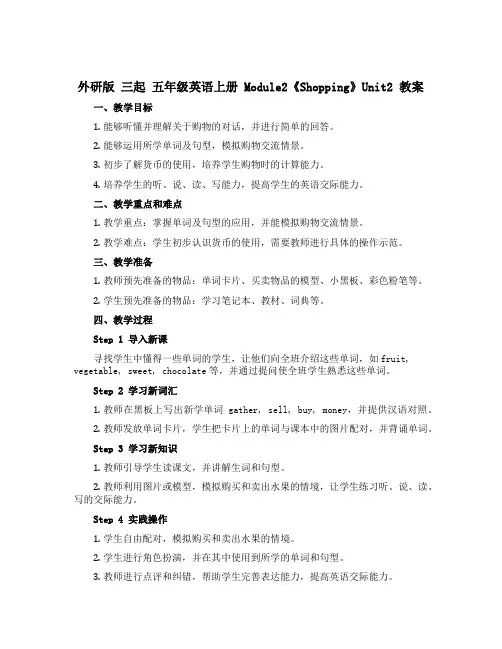
外研版三起五年级英语上册 Module2《Shopping》Unit2 教案一、教学目标1.能够听懂并理解关于购物的对话,并进行简单的回答。
2.能够运用所学单词及句型,模拟购物交流情景。
3.初步了解货币的使用,培养学生购物时的计算能力。
4.培养学生的听、说、读、写能力,提高学生的英语交际能力。
二、教学重点和难点1.教学重点:掌握单词及句型的应用,并能模拟购物交流情景。
2.教学难点:学生初步认识货币的使用,需要教师进行具体的操作示范。
三、教学准备1.教师预先准备的物品:单词卡片、买卖物品的模型、小黑板、彩色粉笔等。
2.学生预先准备的物品:学习笔记本、教材、词典等。
四、教学过程Step 1 导入新课寻找学生中懂得一些单词的学生,让他们向全班介绍这些单词,如fruit, vegetable, sweet, chocolate等,并通过提问使全班学生熟悉这些单词。
Step 2 学习新词汇1.教师在黑板上写出新学单词gather, sell, buy, money,并提供汉语对照。
2.教师发放单词卡片,学生把卡片上的单词与课本中的图片配对,并背诵单词。
Step 3 学习新知识1.教师引导学生读课文,并讲解生词和句型。
2.教师利用图片或模型,模拟购买和卖出水果的情境,让学生练习听、说、读、写的交际能力。
Step 4 实践操作1.学生自由配对,模拟购买和卖出水果的情境。
2.学生进行角色扮演,并在其中使用到所学的单词和句型。
3.教师进行点评和纠错,帮助学生完善表达能力,提高英语交际能力。
Step 5 课堂小结教师总结本节课学到的单词和句型,反复强调学生认识货币的使用,培养计算能力。
五、课后作业请学生将购物过程中所用到的若干单词用句子描述清楚,并准备下节课的复习。
六、教学反思本节课通过不同形式的教学,学生能够掌握这些单词和句型的应用,并且学生也通过角色扮演来提高自己的交际能力。
但是学生的运用货币的能力还需要教师进行具体的操作示范,下节课需要注重教育。
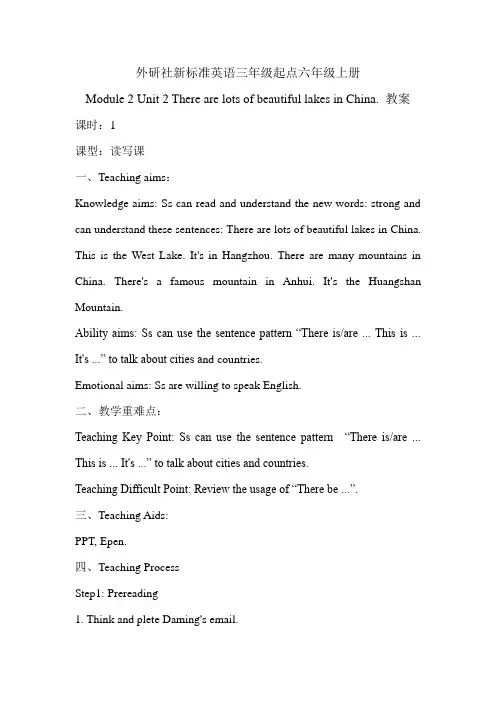
外研社新标准英语三年级起点六年级上册Module 2 Unit 2 There are lots of beautiful lakes in China. 教案课时:1课型:读写课一、Teaching aims:Knowledge aims: Ss can read and understand the new words: strong and can understand these sentences: There are lots of beautiful lakes in China. This is the West Lake. It's in Hangzhou. There are many mountains in China. There's a famous mountain in Anhui. It's the Huangshan Mountain.Ability aims: Ss can use the sentence pattern “There is/are ... This is ... It's ...” to talk about cities a nd countries.Emotional aims: Ss are willing to speak English.二、教学重难点:Teaching Key Point: Ss can use the sentence pattern “There is/are ... This is ... It's ...” to talk about cities and countries.Teaching Difficult Point: Review the usage of “There be...”.三、Teaching Aids:PPT, Epen.四、Teaching ProcessStep1: Prereading1. Think and plete Daming's email.T: Last class, we all know, Daming misses his family in China, he is sending an email to his family, Now let's think and plete the email and review New York's Chinatown.2. Listen and say. What places can you hear?3. Listen and chant. A1Then, look and say the feature of these places.Step2 Whilereading1. Listen and plete.2. Listen, look and plete.3. Read and plete.Does Daming want to go to Chinatown now? And why?4. Listen and imitate.5. Read by yourselves.Step3 Postlistening1. Look and say. A32. Look and write. Then say. A43. Look, remember and say. A64. Watch and sing.5. Write about your city.Step 4 Homework1. Listen and imitate the new words and text for three times. 听录音模仿跟读新单词和课文三遍。
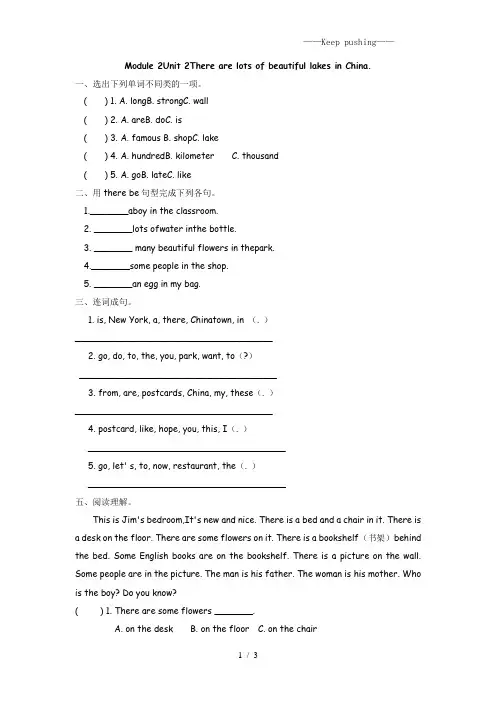
Module 2Unit 2There are lots of beautiful lakes in China.一、选出下列单词不同类的一项。
( ) 1. A. longB. strongC. wall( ) 2. A. areB. doC. is( ) 3. A. famous B. shopC. lake( ) 4. A. hundredB. kilometer C. thousand( ) 5. A. goB. lateC. like二、用there be句型完成下列各句。
1._______aboy in the classroom.2. _______lots ofwater inthe bottle.3. _______ many beautiful flowers in thepark.4._______some people in the shop.5. _______an egg in my bag.三、连词成句。
1. is, New York, a, there, Chinatown, in (. )____________________________________2. go, do, to, the, you, park, want, to(?)____________________________________3. from, are, postcards, China, my, these(. )____________________________________4. postcard, like, hope, you, this, I(. )____________________________________5. go, let' s, to, now, restaurant, the(. )____________________________________五、阅读理解。
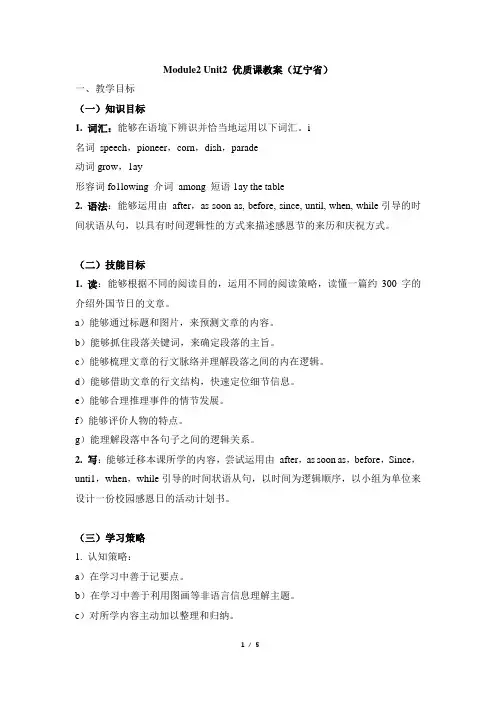
Module2 Unit2 优质课教案(辽宁省)一、教学目标(一)知识目标1. 词汇:能够在语境下辨识并恰当地运用以下词汇。
i名词speech,pioneer,corn,dish,parade动词grow,1ay形容词fo1lowing 介词among 短语1ay the table2. 语法:能够运用由after,as soon as, before, since, until, when, while引导的时间状语从句,以具有时间逻辑性的方式来描述感恩节的来历和庆祝方式。
(二)技能目标1. 读:能够根据不同的阅读目的,运用不同的阅读策略,读懂一篇约300字的介绍外国节日的文章。
a)能够通过标题和图片,来预测文章的内容。
b)能够抓住段落关键词,来确定段落的主旨。
c)能够梳理文章的行文脉络并理解段落之间的内在逻辑。
d)能够借助文章的行文结构,快速定位细节信息。
e)能够合理推理事件的情节发展。
f)能够评价人物的特点。
g)能理解段落中各句子之间的逻辑关系。
2. 写:能够迁移本课所学的内容,尝试运用由after,as soon as,before,Since,unti1,when,while引导的时间状语从句,以时间为逻辑顺序,以小组为单位来设计一份校园感恩日的活动计划书。
(三)学习策略1. 认知策略:a)在学习中善于记要点。
b)在学习中善于利用图画等非语言信息理解主题。
c)对所学内容主动加以整理和归纳。
2. 交际策略a)善于抓住用英语交际的机会。
b)在交际中,把注意力集中在意思的表达上。
c)借助手势、表情等体态语进行交流。
3. 自学策略:能够通过网络,查阅更多关于西方节日的资料,加深对不同文化传统的认识。
4. 合作学习策略:在小组活动中,善于听取别人的意见,并积极贡献自己的力量。
(四)情感态度加深学生对西方节日的了解,培养学生的感恩之心。
二、学情分析1. 模块的话题是节假日活动,九年级的学生对这个话题即熟悉又很有兴趣。
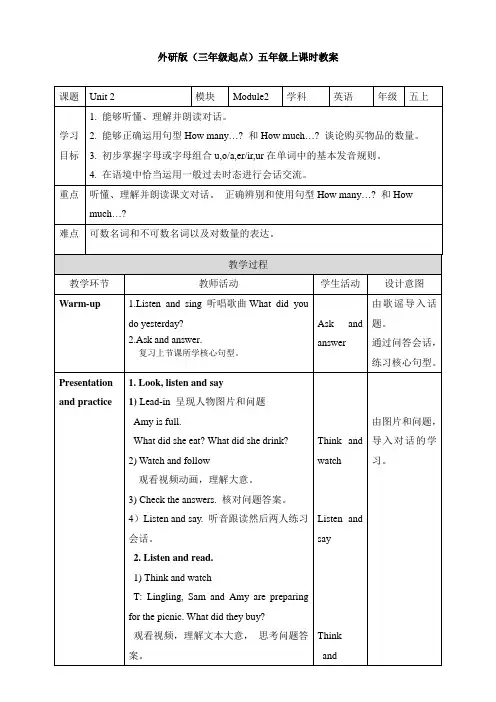
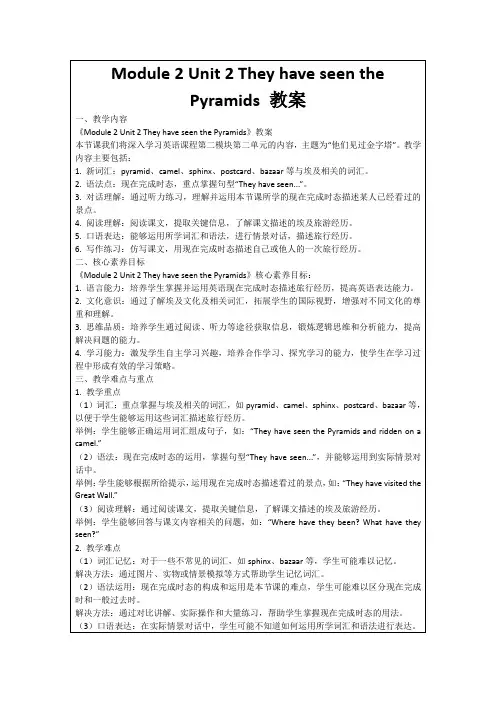
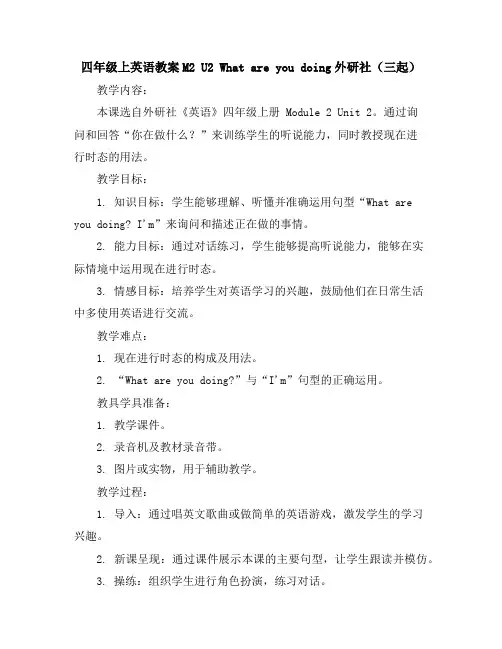
四年级上英语教案M2 U2 What are you doing外研社(三起)教学内容:本课选自外研社《英语》四年级上册 Module 2 Unit 2。
通过询问和回答“你在做什么?”来训练学生的听说能力,同时教授现在进行时态的用法。
教学目标:1. 知识目标:学生能够理解、听懂并准确运用句型“What are you doing? I'm”来询问和描述正在做的事情。
2. 能力目标:通过对话练习,学生能够提高听说能力,能够在实际情境中运用现在进行时态。
3. 情感目标:培养学生对英语学习的兴趣,鼓励他们在日常生活中多使用英语进行交流。
教学难点:1. 现在进行时态的构成及用法。
2. “What are you doing?”与“I'm”句型的正确运用。
教具学具准备:1. 教学课件。
2. 录音机及教材录音带。
3. 图片或实物,用于辅助教学。
教学过程:1. 导入:通过唱英文歌曲或做简单的英语游戏,激发学生的学习兴趣。
2. 新课呈现:通过课件展示本课的主要句型,让学生跟读并模仿。
3. 操练:组织学生进行角色扮演,练习对话。
4. 巩固:通过听录音,让学生跟读并模仿,进一步巩固所学内容。
板书设计:1. Module 2 Unit 2 What are you doing?2. 句型:What are you doing? I'm3. 现在进行时态的构成:主语 + be动词(am/is/are) + 动词ing形式。
作业设计:1. 听录音,跟读课文。
2. 用所学句型编写一段对话,描述家庭成员正在做的事情。
3. 家长签字,确认作业完成情况。
课后反思:1. 教学过程中,注意观察学生的学习情况,适时调整教学节奏和难度。
2. 鼓励学生积极参与课堂活动,提高他们的英语表达能力。
3. 对学生的学习成果进行评价,及时给予反馈和鼓励。
重点关注的细节:教学难点教学难点是教学过程中的关键环节,它直接关系到学生对知识点的理解和掌握。
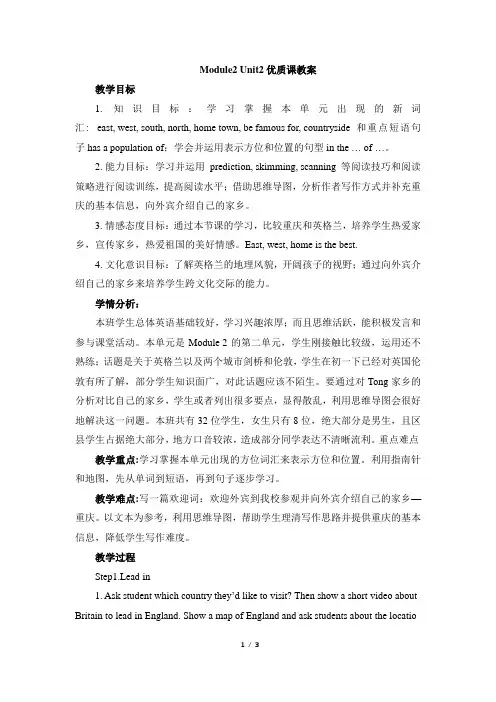
Module2 Unit2优质课教案教学目标1. 知识目标:学习掌握本单元出现的新词汇: east, west, south, north, home town, be famous for, countryside和重点短语句子 has a population of;学会并运用表示方位和位置的句型 in the … of …。
2. 能力目标:学习并运用prediction, skimming, scanning等阅读技巧和阅读策略进行阅读训练,提高阅读水平;借助思维导图,分析作者写作方式并补充重庆的基本信息,向外宾介绍自己的家乡。
3. 情感态度目标:通过本节课的学习,比较重庆和英格兰,培养学生热爱家乡,宣传家乡,热爱祖国的美好情感。
East, west, home is the best.4. 文化意识目标:了解英格兰的地理风貌,开阔孩子的视野;通过向外宾介绍自己的家乡来培养学生跨文化交际的能力。
学情分析:本班学生总体英语基础较好,学习兴趣浓厚;而且思维活跃,能积极发言和参与课堂活动。
本单元是Module 2的第二单元,学生刚接触比较级,运用还不熟练;话题是关于英格兰以及两个城市剑桥和伦敦,学生在初一下已经对英国伦敦有所了解,部分学生知识面广,对此话题应该不陌生。
要通过对Tong家乡的分析对比自己的家乡,学生或者列出很多要点,显得散乱,利用思维导图会很好地解决这一问题。
本班共有32位学生,女生只有8位,绝大部分是男生,且区县学生占据绝大部分,地方口音较浓,造成部分同学表达不清晰流利。
重点难点教学重点:学习掌握本单元出现的方位词汇来表示方位和位置。
利用指南针和地图,先从单词到短语,再到句子逐步学习。
教学难点:写一篇欢迎词:欢迎外宾到我校参观并向外宾介绍自己的家乡—重庆。
以文本为参考,利用思维导图,帮助学生理清写作思路并提供重庆的基本信息,降低学生写作难度。
教学过程Step1.Lead in1. Ask student which country they’d like to visit? Then show a short video about Britain to lead in England. Show a map of England and ask students about the location of the places. Students learn to express the location with “in the east/ west/ south/ no rth… of England”.2. Ask students to read the title. Then guess what we’ll learn from the passage. P ut their ideas on the Blackboard to see if their predictions are right.Step2.While-reading1. Skimming for structureStudents read and match the headlines with the paragraphs.Then teacher shows the structures and asks students to choose the right structure of the passage.2. Scanning for details1) Students read Para 1 and Para 2 to complete the chart in Activity 3. Teacher as ks them tocheck the answers by working in pairs to ask and answer about the information of Cambridge and London. Then compare the two cities.2) Students read Para 3 and Para 4 to tell if the statements are true or false with t he evidence in the passage.3. Retelling the passageStudents complete the chart with the information of England and then work in gr oup to retell the whole passage.Then finish activity 4.Step3.Post-reading.1) Discuss if Tony likes his hometown and find the evidences in the passage.2) Compare Chongqing with London with “…than…;as…as…”.3) Learn the saying, “East, west, home is the best.”Step 4. Mind-map1. Analyze the way of Tony’s writing about his hometown.2. Finish drawing the mind-map to introduce our hometown Chongqing.Step 5. Writing1. Tell students Professor Larson and Dr. Murray from MIT will visit our school next week and we’ll give a speech to welcome them and introduce Chongqing to them.2. Students write a speech and then give their speeches in front of the whole class .Step 6. HomeworkAsk students to write a passage to introduce their home town like Activity 6 after class.教学反思本节课的教学内容目标顺利达成。
Module 2 My home town and my countryUnit 2 Cambridge is a beautiful city in the east of England.教学目标【知识目标】1、能够正确使用下列单词和词组:in the east of、home town、especially、be famous for、a population of、area、low、island、mountain、countryside、university2、掌握形容词比较级用法。
【能力目标】1、能读懂关于介绍剑桥、伦敦、英国的短文,了解文章主旨,并找到相关的细节信息。
2、能够使用所学的语言介绍自己的家乡。
【情感态度目标】培养学生热爱家乡、热爱祖国的感情教学重难点【教学重点】1、能读懂关于介绍剑桥、伦敦、英国的短文,了解文章主旨,并找到相关的细节信息。
2、能够使用所学的语言介绍自己的家乡。
【教学难点】教学过程Step 1 Lead-inAnswer the questions according to the pictures, and let Ss know about England.Step 2 Consolidate new words1. Point out the direction words.2. Look and say. The teachers shows the pictures of new words and let the students to say as quickly as possible.Step 3 Look at the map of the England and read these sentences.1. Cambridge is in the east of England.2. London is in the south of England.3. Bristol is in the west of England.4. Manchester is in the north of England.Step 4 Make a dialogue about the directionsLook at the pictures and make dialogues about the cities on the map.Step 5 Point out the directionsLook at the map of China and point out the locations of the following cities.Beijing Guangdong Chengdu ShanghaiStep 6 Listen and answer the questions1. Where is Cambridge?2. What’s the capital of England?Step 7 Read the passage1. Read the passage and answer the questions.(1)What’s its population of Cambridge?(2)What’s Cambridge famous for?(3)How old is London?(4)What’s the weather like in England?2. Read the passage and choose a title for each picture below.3. Complete the table comparing Cambridge with London.4. Complete the passage with the words and expressions in the box.Step 8 Main pointsTo learn about the main points in the passage.Step 9 Answer the questions and write notes about your home town1. Where is it?2.What’s its population?3. Is it big or small?4. What is it famous for?5. How old is it?6. What is the weather like?Step 10 Use your notes and write answers to the questions in Activities 5 Dalian is in the northeast of China.It has a population of over six million.Step 11 Write a passage called My home town. Use Tony’s passage to help you Dalian is in the northeast of China and it has a population of over six million. It is …Step 12 SummaryLet Ss talk about what they have learnt in class.Step 13 ExercisesLet the students practice the main points in Unit 2.课堂作业Describe the city that you dream to visit for a long time.教学反思。
Module 2 Public holidaysUnit 2 We have celebrated the festival since thefirst pioneers arrived in America.主备人:___ _ _ 审核人:____ _______ 复备人:____________课型:Reading and writing教学目标:1. To learn some key words and useful expressions: among, speech, pioneer, grow, corn, following, lay, over, dish, ourselves, lay the table, give thanks (to sb.) for (doing) sth.2. To read and get information from reading material about the Thanksgiving Day.3. To write a composition about the festival by using the adverbial clause of time.教学重难点:1. To master the new words and get information from the article..2. To write a composition by using the adverbial clause of time.教学准备:课堂整体运用任务型教学模式以及阅读课“四个阶段”教学模式。
本课指导学生通过阅读获取信息,培养学生阅读技能。
在教学过程中,采用多媒体手段辅助教学,利用各种图片和习题任务贯穿整个教学过程。
因此,本节课需准备:PPT课件、挂图、录音机、课堂练习表格、奖品.预习要求:1、根据音标自学本课新单词;2、查找相关资料,找出你认为本课较重要的语言点和短语。
Modue2 Unit2 参考教案一、教学内容外语教学与研究出版社(一起点)五年级上册第二模块Unit2 The e man different thing二、教学过程建议(一)热身导入1 师生互致问候。
请学生用“There be”结构介绍周边超市里都有什么商品并描述商品的颜色、大小等特征。
2 展示SB Unit2活动1的挂图,请学生看图并猜测: “Tinging在做什么?英国小朋友看到后反应如何?”然后教师继续问学生: “大家平时是否喜欢看戏曲表演?对中国戏曲了解多少?”教师可以借此机会,向学生介绍中国的戏曲文化,增强学生的民族自豪感。
3 播放动画或录音请学生看动画或边听录音边看挂图,理解语境。
再次播放录音,请学生跟读。
在跟读过程中,请学生注意模仿语音语调,并学习如何表达惊叹和赞美。
4 播放第三遍录音,请学生全班跟读、小组跟读、个人跟读。
(二)任务呈现1 教师告诉学生:“此单元我们将继续谈论在超市购物的话题,并进一步了解英国的超市。
此外,学习完今天的课文后,大家要设计自己喜欢的商店的海报,并向全班同学介绍。
现在我们先来认真学习课文吧。
”(三)课文学习1 展示SB Unit2活动2的挂图,请学生看图,说一说图中都有什么商品。
教师先向学生示范:“Thee cothe The e to The e CD 请学生猜一猜“e”的意思,并描述图中其他物品。
然后播放动画或录音,请学生看动画或边听录音边看挂图,理解课文语境。
2 再次播放录音,请学生完整地听一遍。
播放第三遍录音,请学生逐句跟读。
在跟读过程中,讲解单词“e, ometime”,并对单词“ometime”进行运用训练。
3 鼓励学生用自己的语言对超市进行综合描述。
教师可以在学生说的过程中给予一定的帮助,使学生说得完整、顺畅,教师应及时表扬语言表达有创意的学生。
然后教师可以出示一些自己查到的国外知名超市的图片,请学生欣赏,帮助学生进一步了解国外超市。
(四)训练巩固1 完成SB Unit2活动3。
Unit 2 There are lots of beautiful lakes in China. 教学目标
学习单词:miss, sometimes, restaurant, really, dancing, shop
学习句子:There’s a Chinatown in New York!
There are lots of Chinese shops and restaurants there.
教学重点:
识记单词:miss, sometimes, restaurant, really, dancing, shop
运用句子There’s a Chinatown in New York!There are lots of Chinese shops and restaurants there.这类语句描述地方特征。
教学难点
用“There be”句型描述事物
教学过程
一、热身复习
向全班问好,请几位学生把上节课的家庭作业读给全班同学听。
请学生回忆Daming与Simon的对话,并提出相关的问题:“Do you remember Chinatown from the last unit? Where is it?”引导学生做出相应的回答。
二、导入
让学生先观察图片,猜猜都是中国的什么地方。
三、学习新课
1.播放录音,让学生给所听到的录音图片排序。
接着让学生跟读。
试着让学生用自己的语言描述图片上的内容。
2.现在可以变换练习方式。
请学生两人一组.向对方介绍六张明信片中自己最喜欢的一张。
如果有必要,可以再放一遍录音,请学生逐句跟读,并试着抓住每张明信片最主要的特征.然后再向同伴讲述。
鼓励学生根据图片进行更多描述,或是把自己对该事物的了解添加到描述中去。
3.重音的学习:请学生听SB unit 2活动3的录音,之后让学生试着跟读一遍。
要求他们注意重读的地方。
请学生把书翻到SB unit 2活动3,仔细看书上的句子以及每句话中用黑体标出的地方,比较一下自己刚才跟读时重读的位置与书上的标注是否一致。
老师再放录音,学生边听边看书,认真体会。
4.学习歌曲:完成SB unit 2活动4,请学生欣赏并学习一首歌曲。
放录音前,请学生们先试着通过文字和图片猜测歌曲的内容。
四、巩固练习
1.现在学生衣服上的图案很丰富.教师可让一个学生站在黑板前,让其他学生用“There be”句型来描述学生衣服上的图案。
如: There are some ducks on her dress.
2.四人小组,运用“There be”句型描述自己所带的照片,也可以是收集的他人的照片,或风景人物照等.
如: There are some children are playing football in the playground.
五、课堂检测
(一)翻译下列短语
1.长城
2. 长江
3. 天安门广场
4 . 西湖
5、一张关于长城的图片
6、给我的家人发一封电子邮件
7、去唐人街
8、许多,大量
9、中国舞蹈
10、中国商店和餐馆
(二)用“is”或“are”填空。
1. There ____a computer on the desk.
2. What ____you doing?
3. He ____in the park.
4. There ____the tables in the room.
5. We ____good friends.
6.—We _____good student?—Yes, she___.
7. Peter and Jim ____brothers.
(三)课后作业
每天听录音10分钟;
学生挑选一张本地风景的明信片,用英文进行简单的描写和介绍,然后把明信片寄给自己的外国朋友或是其他好友。